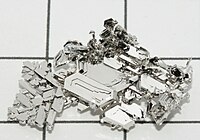
Photo from wikipedia
To accelerate the discovery of materials through computations and experiments, a well-established protocol closely bridging these methods is required. We introduce a high-throughput screening protocol for the discovery of bimetallic… Click to show full abstract
To accelerate the discovery of materials through computations and experiments, a well-established protocol closely bridging these methods is required. We introduce a high-throughput screening protocol for the discovery of bimetallic catalysts that replace palladium (Pd), where the similarities in the electronic density of states patterns were employed as a screening descriptor. Using first-principles calculations, we screened 4350 bimetallic alloy structures and proposed eight candidates expected to have catalytic performance comparable to that of Pd. Our experiments demonstrate that four bimetallic catalysts indeed exhibit catalytic properties comparable to those of Pd. Moreover, we discover a bimetallic (Ni-Pt) catalyst that has not yet been reported for H 2 O 2 direct synthesis. In particular, Ni 61 Pt 39 outperforms the prototypical Pd catalyst for the chemical reaction and exhibits a 9.5-fold enhancement in cost-normalized productivity. This protocol provides an opportunity for the catalyst discovery for the replacement or reduction in the use of the platinum-group metals.
Journal Title: npj Computational Materials
Year Published: 2021
Link to full text (if available)
Share on Social Media: Sign Up to like & get
recommendations!